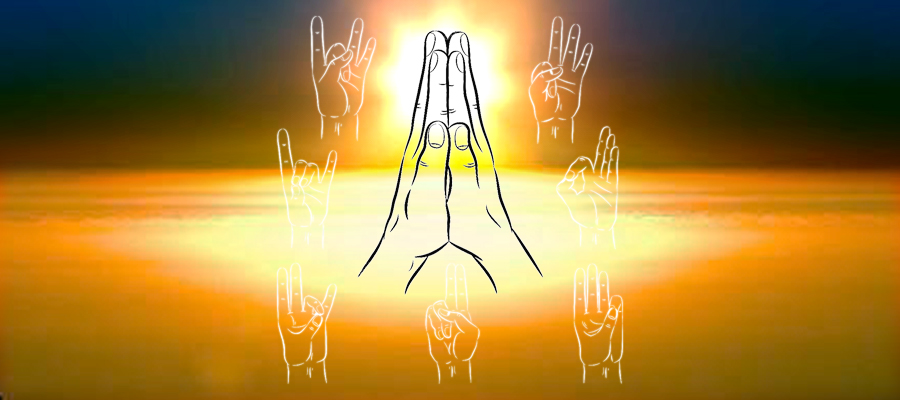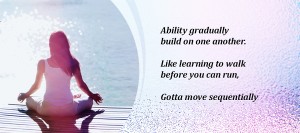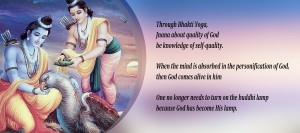- 1How Does the Hand of Yoga Work?
- 2Practicing Mudra Yoga
- 2.1Yoga Mudras Through by Breathing, Affirmations, and Visualization
- 3Types of Mudras in Yoga
- 4Mudra Yoga by Hand
- 5Benefits of Mudra Yoga
- 6Yoga Mudras for Meditation on each Chakra
- 6.1.11. Muladhara Mudra
- 6.1.22. Sacral Mudra (Shakti Mudra)
- 6.1.33. Mudra Rudra (Solar Plexus)
- 6.1.44. Padma Mudra
- 6.1.55. Granthita Mudra
- 6.1.66. Ajna Mudra
- 6.1.77. Sahasrara Mudra
Practicing Mudra Yoga
All we have to do is place the hands and fingers into the correct formation. For example, to make the Karana Mudra simply stretch out our fifth and second fingers and roll our remaining fingers inward so that the thumb touches the third finger.
Tips in Practice:
- When practicing yoga mudras [see list of mudras below] we should only have minimal pressure on the fingers and hands should feel relaxed and without tension. Sometimes this might be a challenge. Some mudras are quite complex. For example, the Shakti mudra requires making a fist while holding out the fourth finger up and the fifth finger outward. The Shakti Mudra cool for young practitioners is a challenge for the elderly and especially for people with arthritis. But thankfully, not all mudras are as complex as Shakti mudras.
- We might notice that striving to make certain mudras. Maybe we can do mudras with one hand but not with the other, or we need to use one hand to support the other before we can do mudras. In that case, just do what needs to be done to do the mudra comfortably. If we can only make mudras with one hand while using the other to support, that’s fine.
- The more we practice mudras the more comfortable we are with them and the less pain we have in the appropriate parts of our body.
- But keep in mind, mudras don’t need to be done perfectly to have an effect. Do your best, and believe that the more practice the easier.
- We can do a mudra in one of the meditation positions. Lie down, sit down, stand up, everything’s fine. The only exception to this is when mudras involve certain body positions.
- Like meditation, when we practice mudras it is recommended to have good posture. Make sure the spine is in a straight position and the whole body relaxes without tension (except for certain yoga mudras, such as the Maha mudra above, who deliberately uses tension in the body).
- Relaxation is important for the flow of energy throughout the body, whether it is Kundalini energy, prana, chi, or other types of energy, the more relaxed, the better the energy will flow.
- We might also want to use pranayama (rhythmic breathing used in Yoga) to get more into the mudra.
When using the hands/cubits mudra can meditate in one of the various types of meditation. Or maybe choose to think of something.
Unlike in meditation, when practicing yoga mudra, you can think of other things if you want. However, for the best effect, you should meditate. The choice belongs entirely to the practitioner. Thinking about something won’t prevent mudras from working.
If meditating, the best type of meditation to use is basic breathing meditation. Beware pranayama, the flow of breath rhythm throughout the body. And for the best effect with many mudras will want to adopt certain positions while visualizing certain things when using mudras. The complete combination of these elements can cause profound changes in the mind and body.
Where and when to practice mudras
It is entirely up to practitioners when and where to practice mudras. Make sure you are relaxed and focused. Some of the best times to use mudras are in the morning, during lunch breaks, after work, and before going to bed. As mentioned, it is entirely up to practitioners when practicing mudras. Try to relax and focus. If you really want a profound transformational experience, go to a relaxed and beautiful place of nature and try to practice mudra there. We will like it more.
A period of time is needed for mudra yoga to be effective.
For a beginner, it is necessary to use the mudra for at least ten minutes before affecting the mind. If switching from one mudra to the next mudra will not experience a good mental effect, one will only get a faint impression of one state, and then another and so on. It is far better to remain with one mudra and actually enter into the mudra so that it can experience it fully.
Choose one mudra and keep it for at least ten minutes before continuing.
When we use mudras, they change our mental state. Every change of mind brings a change. But it will take time to truly experience that change. So, when starting, leave a few hours between different mudras.
Kinesiologist Kim da Silva, a mudra expert recommends choosing how long we will hold the mudra before it starts. This helps to stop interference. If you do not set a time, it will not be conducive to high mental states.
Some mudras are used for health conditions. For example, Lingga mudra can be used for lung complications. Mudras like these should only be used as long as needed. When completing mudras, maybe want to be quiet and silent for ten minutes and meditate on breathing. This is a great way to complete a mudra session.
Yoga Mudras Through by Breathing, Affirmations, and Visualization
Holding the actual hand position of the mudra is the basic foundation of experience. If you want to improve your experience, you can do this using visualization, affirmation and breathing techniques.
The first and most important of these increases is breath or pranayama.
Here’s what you need to know:
- We must ensure that we have good posture whenever we use mudras. The spine must be parallel and the arms, relaxed around the sides of the body.
- Before starting the mudra session, be sure to breathe deeply (diaphragm). The easiest way to do this is to use breathing meditation for several minutes.
- If using mudras for relaxation, breathe deeply in a slow and relaxed way.
- If you use mudras to produce energy or to freshen up, breathe harder.
- Overall, breathing must flow, have energy, be deep and slow.
- When inhaling, it can put a little more pressure on the hands and fingers.
- When exhaling, relax your hands and fingers (while maintaining the mudra).
- And can add visualization and affirmations for mudras. The exact visualization and affirmation will depend on the mudra used.
There are many other ways to improve mudra practice. Basically, any method that can be done to influence mood can also be used to improve meditation practice. For example by listening to soothing music in order to be uplifting.





